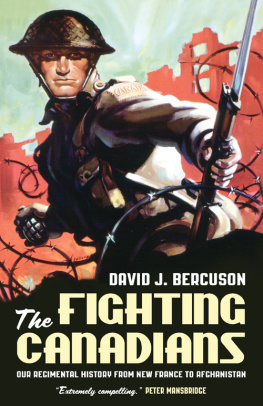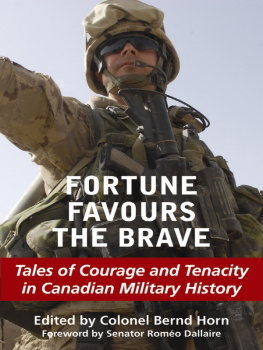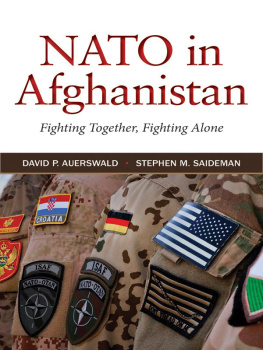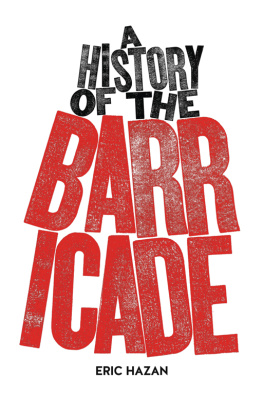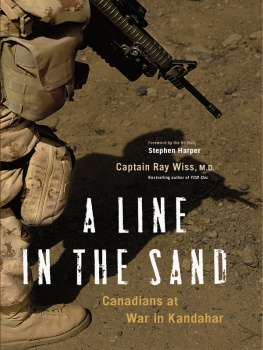David J. Bercuson - Fighting Canadians: Our Regimental History from New France to Afghanistan
Here you can read online David J. Bercuson - Fighting Canadians: Our Regimental History from New France to Afghanistan full text of the book (entire story) in english for free. Download pdf and epub, get meaning, cover and reviews about this ebook. year: 2008, publisher: Harpercollins Canada, genre: History. Description of the work, (preface) as well as reviews are available. Best literature library LitArk.com created for fans of good reading and offers a wide selection of genres:
Romance novel
Science fiction
Adventure
Detective
Science
History
Home and family
Prose
Art
Politics
Computer
Non-fiction
Religion
Business
Children
Humor
Choose a favorite category and find really read worthwhile books. Enjoy immersion in the world of imagination, feel the emotions of the characters or learn something new for yourself, make an fascinating discovery.
- Book:Fighting Canadians: Our Regimental History from New France to Afghanistan
- Author:
- Publisher:Harpercollins Canada
- Genre:
- Year:2008
- Rating:3 / 5
- Favourites:Add to favourites
- Your mark:
- 60
- 1
- 2
- 3
- 4
- 5
Fighting Canadians: Our Regimental History from New France to Afghanistan: summary, description and annotation
We offer to read an annotation, description, summary or preface (depends on what the author of the book "Fighting Canadians: Our Regimental History from New France to Afghanistan" wrote himself). If you haven't found the necessary information about the book — write in the comments, we will try to find it.
David J. Bercuson: author's other books
Who wrote Fighting Canadians: Our Regimental History from New France to Afghanistan? Find out the surname, the name of the author of the book and a list of all author's works by series.
Fighting Canadians: Our Regimental History from New France to Afghanistan — read online for free the complete book (whole text) full work
Below is the text of the book, divided by pages. System saving the place of the last page read, allows you to conveniently read the book "Fighting Canadians: Our Regimental History from New France to Afghanistan" online for free, without having to search again every time where you left off. Put a bookmark, and you can go to the page where you finished reading at any time.
Font size:
Interval:
Bookmark:
For F.P.M.
THERE IS NOTHING more difficult to explain to those who have little knowledge of military history or traditions than what a regiment is. Yet the very concept of the regiment, as well as the nurturing of both individual regimental lore and the broader regimental tradition, is one of the main attributes of soldiering. Thus my immediate reaction to Jim Giffords suggestion that I write a book on Canadas regimental tradition was to leap at the chance. My second reaction was to wonder exactly how I would explain so complicated a concept. Because I am a historian, I decided to do it through a review of the role that regiments have played in Canadian history from the very beginning to now.
Regiments are first and foremost agglomerations of soldiers that have been created to keep the soldiers steady, focused, and firm in the lead-up to the chaos and bloodletting of battle. Battle lies at the heart of a regiments history and its traditions. Regiments that are newly minted and have never participated in battle borrow from the regimental lore of allied regiments, which they fashion themselves after and may seek affiliation with. Regiments that have experienced battles place those battles at the core of their identity. The Canadian army inherited its particular regimental tradition from the British army that conquered New France in the Seven Years War and stayed behind to protect Canada from its enemies. The French army that preceded the British had a regimental tradition of its own, but that line of tradition was broken by the conquest. The First Nations of the St. Lawrence Valley had no regiments as such but, like all societies since the dawn of time, fought wars and established special rituals and traditions to guide warrior conduct. In that, they were not unlike the regiments of the Europeans.
There is considerable controversy among both soldiers and scholars as to the benefits and drawbacks of the regimental system. I have replayed that debate in my introduction, but for the most part there is little theory in this book. In my view, explaining what regiments are means explaining what they did. Since I could not write about every regiment, or even sketch the complete history of a number of regimentsthere are, after all, many very good regimental histories on library shelves and in bookstoresI decided to select key events in Canadian military history and examine what selected regiments did on those occasions. My objective was to portray regimental cohesion under the very trying circumstances of war in order to demonstrate why Canadas soldiers still place so much value on the regimental tradition. In doing so, of course, I have traced the history of almost all the regiments of Canadas regular army and many of its reserve regiments.
There is also controversy among soldiers and scholars about regimental antecedents. Regiments have been formed and disbanded throughout Canadian history. New regiments have often claimed to be the successors of preceding regiments, especially when the period between the disbanding of the old formation and the raising of the new one was very short. My own interpretation comes from the authoritative but now very dated The Regiments and Corps of the Canadian Army, published under the authority of the Minister of National Defence in 1964. It contains a strict interpretation of regimental precedent and lineage. If an early regiment was disbanded in 1805, for example, and a successor raised in 1807, the guide considers that no official connection can be considered to exist across the two-year gap, even if the successor contained many of the same officers and men, was raised in the same basic area, or claimed to be an official successor.
It is a hard line to drawand to takebut it is easy to follow, and so I have done. Others are more than welcome to see things differently. After all, it was soldiers who created regiments and soldiers of the British and Canadian (and British Commonwealth) traditions who endowed them with semi-religious characteristics. If the modern Van Doos wish to identify with some famous French regiment of old, or if the Royal Newfoundland Regiment of today wishes to uphold a tradition dating back to the 1803 formation of the Royal Newfoundland Fencibles, who is to say they are wrong?
It is, after all, the men (and now the women too), whose sacrifice has endowed the regimental tradition with the hallowed status it now has, who have made the rules, and they are free to break them or to uphold them as they wish.
David J. Bercuson
Rockyview, Alberta
February 2008
BATTLE HONOURS AND MESS DINNERS: THE REGIMENTAL TRADITION
These bridges will be held to the last man against any attempt by the enemy to seize or destroy the crossings.
Major J.L. Love, Officer Commanding,
Dog Company, Regina Rifles, June 5, 1944
IN THE EARLY MORNING hours of June 6, 1944, the Regina Rifles entered history when they were among the first Canadian units to assault the Normandy beachhead. In the first days of the war, no one would have imagined that the Reginas would have such an auspicious introduction to combat.
When the Canadian armys regular and militia units began mobilizing at the beginning of September 1939, the Regina Rifles were virtually left out. The regiment was only a hundred or so strong in part-time soldiers; most were farm boys from the Regina region and southern Saskatchewan. The Reginas were ordered to provide only local protection in the southern part of the province, which had been one of the hardest hit provinces during the Great Depression. Not only had the farm economy been virtually wiped out by the plunge in wheat prices, but thousands of hectares of prairie topsoil had blown away in the drought conditions of the dirty thirties. Everywhere across the southern reaches of the province, the wind blew drifting soil over abandoned farms. Thousands of rural families had simply deserted what little remained and moved into the cities, west into the Peace River country of Alberta, or to the Pacific coast. To earn a few extra dollars, some of the young men who stayed joined the militiamostly the South Saskatchewan Regiment, created in 1920, or the Regina Rifles, created in 1924mixing with older men, some of whom were veterans of the First World War. They underwent desultory training over the next decade or so, mostly with First World War equipment and uniforms (most of the officers were First World War holdouts). Sports, drilling, and target shooting dominated their preparation.
Then came war, in September 1939, and the mobilization of the 1st and 2nd Canadian Infantry divisions. It appeared that the war would pass Saskatchewan by, but on May 24, 1940, just two weeks after the German invasion of France and the Low Countries, the Regina Rifles were finally mobilized and ordered to expand to full war strengthabout 850 men in total. Nine months later they left Canada for the U.K. as a battalion of the 7th Canadian Infantry Brigade of the 3rd Canadian Infantry Division.
The 3rd Canadian Infantry Division was chosen to be Canadas assault force for the Normandy landings almost purely by happenstance. The 1st Division had been sent to fight in the Mediterranean in the spring of 1943, and a lack of ocean transport made it impossible to return the division to France in time for the invasion. Besides, in the spring of 1944 the division was completely tied up in the battle for Rome. Both conditions also applied to the 5th Canadian Armoured Division, which had been sent to Italy in late 1943. The 2nd Division had been decimated at Dieppe in August 1942 and was still rebuilding; no one thought it was in good enough shape to assault another beach so soon, and in fact it did not enter the Normandy fighting until more than a month after D-Day. The 4th Canadian Armoured Division was not ready to fight until early August 1944, so the 3rd Division got the nod for the assault.
Font size:
Interval:
Bookmark:
Similar books «Fighting Canadians: Our Regimental History from New France to Afghanistan»
Look at similar books to Fighting Canadians: Our Regimental History from New France to Afghanistan. We have selected literature similar in name and meaning in the hope of providing readers with more options to find new, interesting, not yet read works.
Discussion, reviews of the book Fighting Canadians: Our Regimental History from New France to Afghanistan and just readers' own opinions. Leave your comments, write what you think about the work, its meaning or the main characters. Specify what exactly you liked and what you didn't like, and why you think so.

